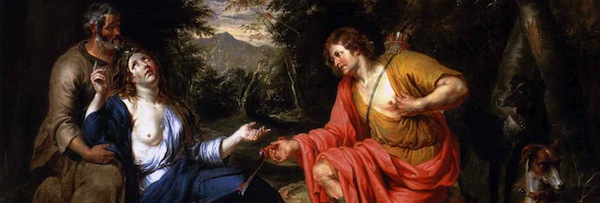Gian Battista Guarini, (several editions) Google Books

This work was originally published in 1589, and the English translation appeared in 1647. Guarini (1538-1612) wrote this pastoral tragicomedy when serving as court poet for Duke Alfonso d’Este II in Ferrara.
As Nicholas Perella indicated, ‘throughout the seventeenth century, the Pastor fido was the most widely read book of secular literature in all of Europe’. 1 This image painted by Pieter van Lint (1609-1690), shows the puerile huntsman, Silvio, and his pursuer, Dorinda, whose intrigues serve as a dramatic sideline to the main plot in Il Pastor Fido concerning the ill-fated lovers Amarilli and Mirtillo.
The work’s mixing of the genres of tragedy and comedy with romantic plot, its lyricism, and its sophisticated and innovative rhetorical style sparked a fierce critical debate between the Ancients and the Moderns. 2 As Aristotle had little to say about the genre of romance, most early modern critics took Aristotle’s silence as signifying
that romance did not conform to the best classical rules for the construction of poetry. The multiple plot of romance . . . violated the norms set down by epic. Similarly, the mixture of the marvellous with the historical threatened the epistemological distinction between the icastic and the phantastic, between faithful imitation and fanciful invention. Romance was thus from the outset associated with innovation, specifically innovation of genre. Like tragicomedy, with which it was often allied or even identified — as in the case of Il Pastor fido, — romance indecorously mixed high and low characters, historical truths and obvious impossibilities, near tragedies with happy endings . . . Romance’s deviation from the law of genre was construed as a form of epistemological and moral deviance . . . In the worst case, disobedience to Aristotle’s rules threatened to slide into spiritual and political disobedience as well. 3.
Lister read this popular and controversial work on 26 January 1664.
- Nicholas Perella, The Critical Fortune of Battista Guarini’s ‘Il Pastor Fido’ (Florence: I.S. Olschki, 1973), 6. ↩
- See http://www.unc.edu/~coluzzi/guarini/pastorfido.htm. ↩
- Victoria Kahn, ‘The Passions and the Interests in Early Modern Europe: The Case of Guarini’s Il Pastor fido‘, Reading the Early Modern Passions: Essays in the Cultural History of Emotion (Philadelphia: University of Pennsylvania Press, 2004), 217-39, on 220-1 ↩
